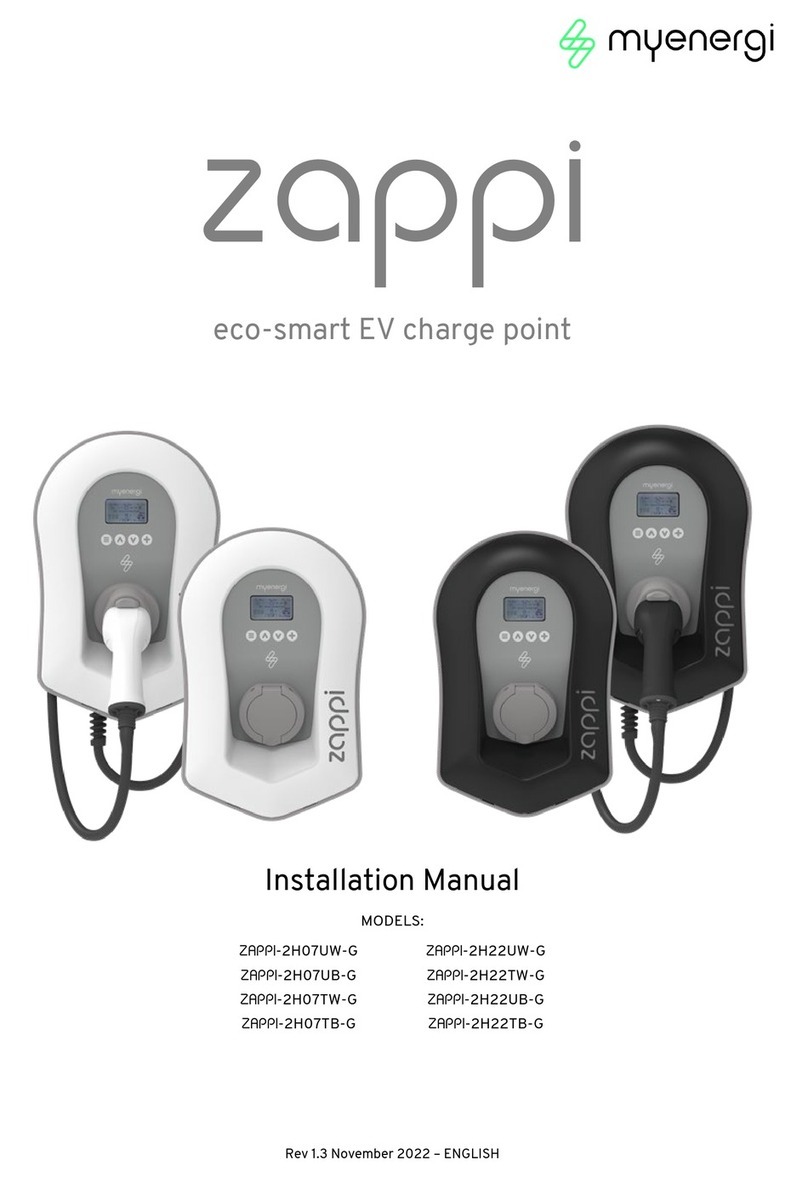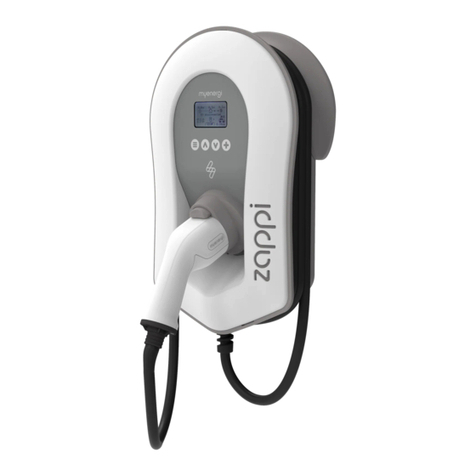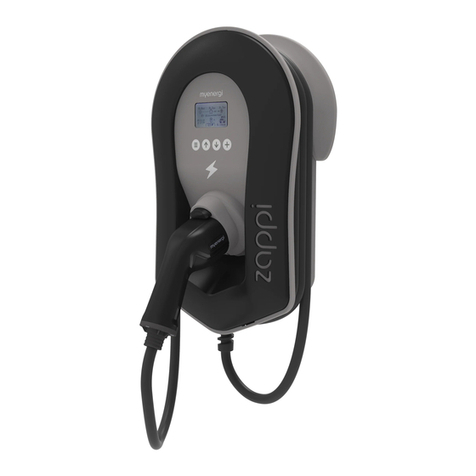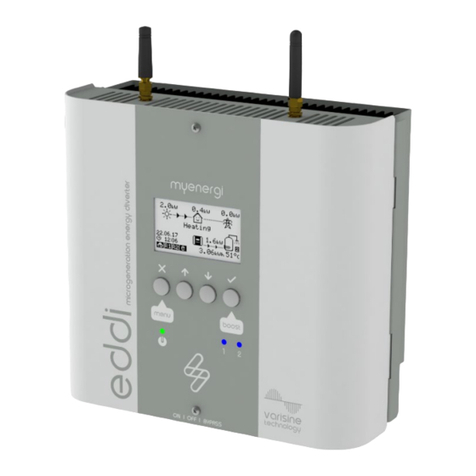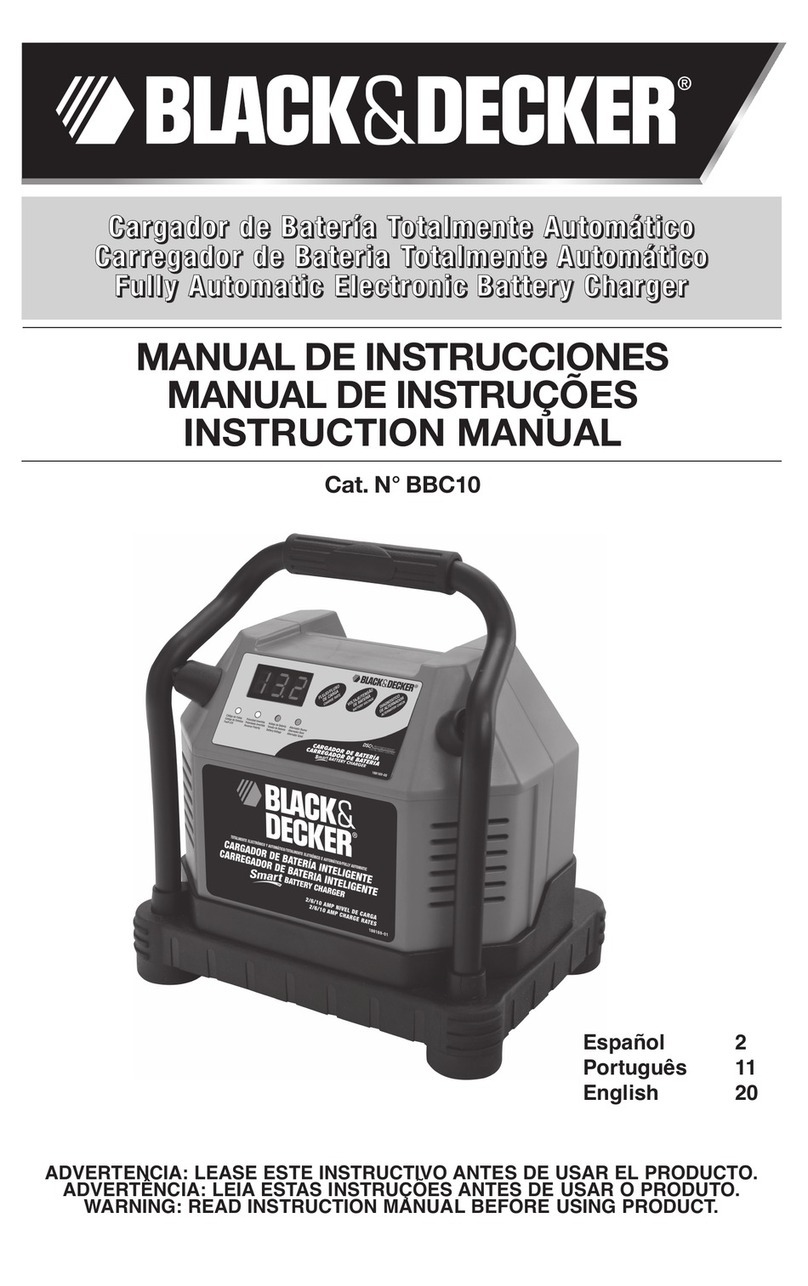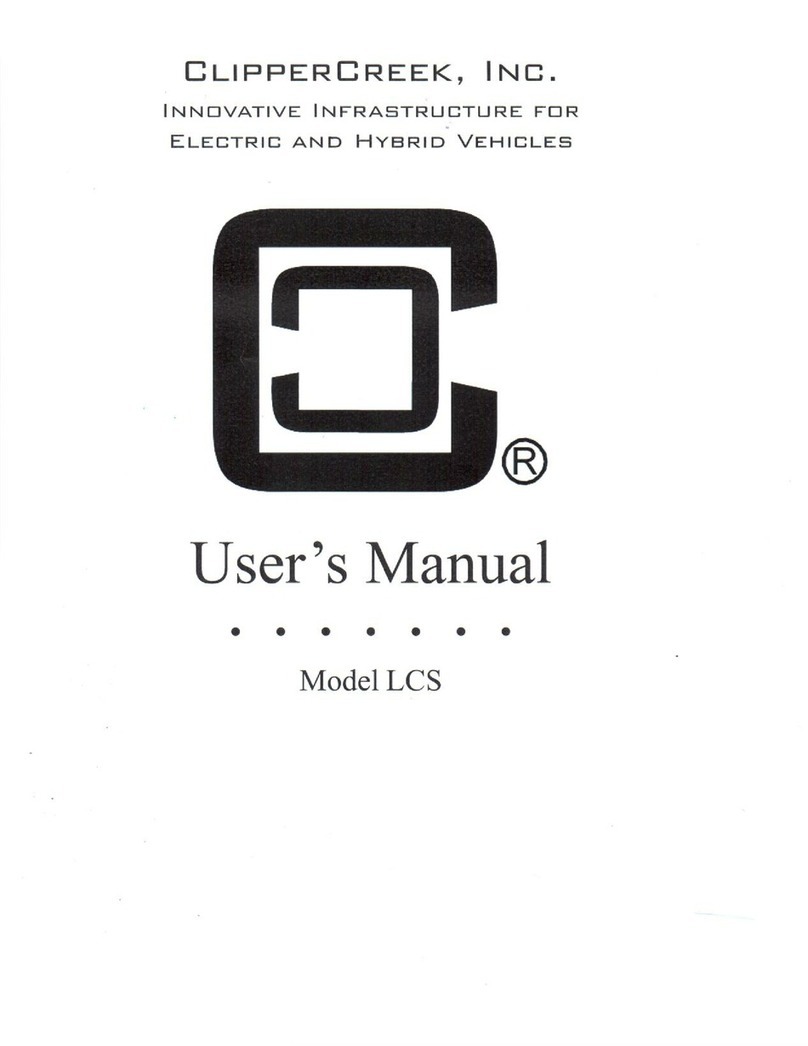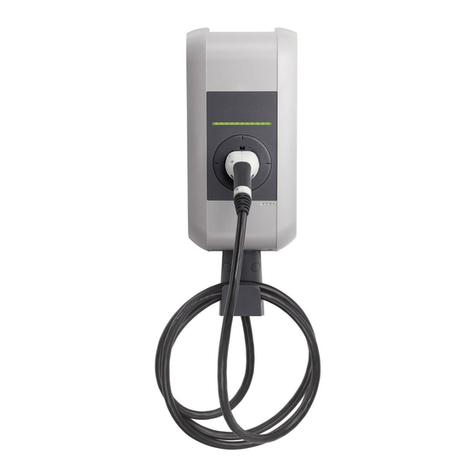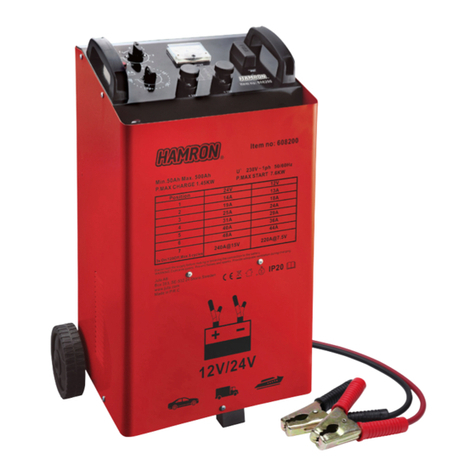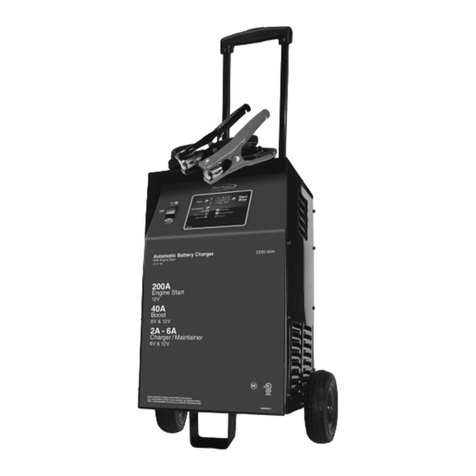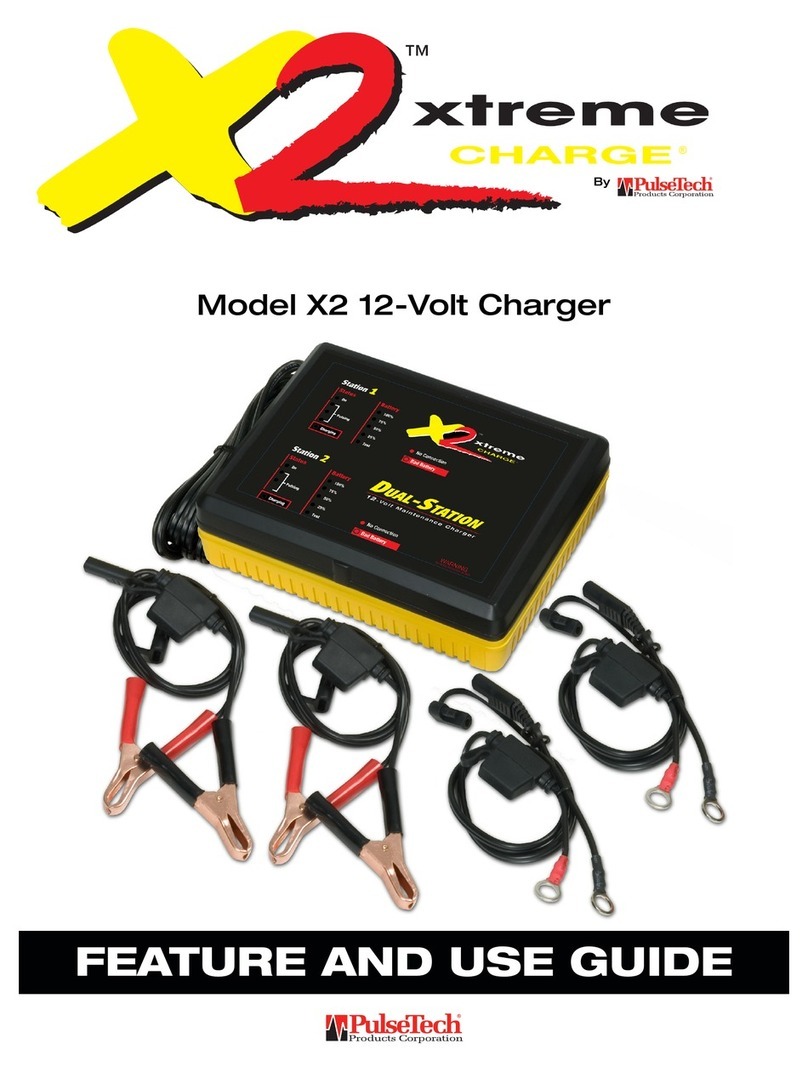Myenergi ZAPPI-2H07UW User manual

Rev 2.1.5 June 2022 – ENGLISH
zappi
eco-smart EV charge point
User Manual
MODELS:
ZAPPI
-2H07UW
ZAPPI-2H07UB
ZAPPI-2H07TW
ZAPPI-2H07TB
ZAPPI
-2H22UW
ZAPPI-2H22TW
ZAPPI-2H22UB
ZAPPI-2H22TB

Page 2of 24
Contents
1. Electric Vehicles (Smart Charge Points) Regulations 2021.........................................................................................3
1.1 Purpose of the Regulations .........................................................................................................................................3
1.2 What’s changed with zappi..........................................................................................................................................3
1.3 Randomised Delay: How it works...............................................................................................................................4
1.4 Smart Scheduling: How it works.................................................................................................................................4
1.5 Defaulting to ‘ECO+’ Mode...........................................................................................................................................5
1.6 Charging Logs..................................................................................................................................................................5
1.7 Installer Requirements..................................................................................................................................................6
2Introduction................................................................................................................................................................................. 7
3Safety............................................................................................................................................................................................ 7
4Disposal ........................................................................................................................................................................................ 7
4. Copyright...................................................................................................................................................................................... 7
5. Overview.......................................................................................................................................................................................8
5.1 Overview Diagram...................................................................................................................................................................8
6. Box Contents.............................................................................................................................................................................10
7. Operation .................................................................................................................................................................................... 11
7.1 Controls & Indicators.................................................................................................................................................... 11
7.2 Display.............................................................................................................................................................................. 12
7.3 Status Screens............................................................................................................................................................... 13
8. Charging Modes....................................................................................................................................................................... 16
9. Manual Boost .............................................................................................................................................................................17
10. Troubleshooting....................................................................................................................................................................... 18
11. Fault Codes................................................................................................................................................................................ 19
12. Warranty....................................................................................................................................................................................20
13. Product Registration.............................................................................................................................................................20
14. Technical Specifications........................................................................................................................................................ 21
14.1 Performance................................................................................................................................................................... 21
14.2 Electrical Specifications ............................................................................................................................................. 21
14.3 Mechanical Specifications.......................................................................................................................................... 21
14.4 Connectivity................................................................................................................................................................... 22
14.5 Max Transmitted Power............................................................................................................................................. 22
15. Model Variants......................................................................................................................................................................... 22
16. Technical Support .................................................................................................................................................................. 23
17.Declaration of Conformity................................................................................................................................................... 23

Page 3of 24
1. Electric Vehicles (Smart Charge Points) Regulations 2021
From 30th June 2022, any EV charger installed in a private setting i.e. home or workplace
NOT public, in England, Scotland and Wales has to meet the Electric Vehicles (Smart Charge
Points) Regulations 2021.
1.1 Purpose of the Regulations
The new smart charging regulations are a huge, positive forward-step by the UK Government in preparing our
homes and businesses for a smart, connected and democratized energy system. Essential tools in driving down
emissions and a core reason why myenergi exists.
The regulations are focused around when you are charging an EV. The aim of the regulations is to prevent
everyone charging at the same time and putting too much demand on the grid.
1.2 What’s changed with zappi
New features have been added to zappi to ensure our products remain compliant with UK Regulations.
These include:
Set-up Wizard – There is a simple wizard for installers to follow at start-up.
See example below:
Date & Time – Allows the zappi to know if it is being installed on or after 30th June 2022. If it is then smart
regulations must apply.
First Device – If this is your first myenergi device the zappi will opt to set the device as Master and turn the
in-built vHub on. If you are adding to an existing myenergi eco-system, the device will opt to set as slave and
turn the in-built vHub off.
Geographic location of installation – If the device is being installed outside of England, Scotland and Wales
the Smart Regulations don’t apply.
Randomised Delay – At the start of a charge and end of a scheduled, Timed Boost there will be a delay
of up to 10 minutes before your vehicle starts and stops charging. This could be a few seconds or it
could be up to the full 10 minutes. This is necessary to ensure everyone does not overload the grid by
starting to charge or ending a charge at the same time. The Randomised Delay can be overridden, if
necessary (See 1.3.2 for further details).
Smart Scheduling – To comply with the smart charging regulations your zappi will be set to charge in
off-peak hours by default. This is between 00:00 – 08:00. You may change this schedule at any time if
you would prefer to charge in peak hours or your electricity tariff off-peak hours differ from those set.
Default to ECO+ mode – If Smart Regulations apply, zappi will default to ECO+ mode on first boot up.
Charging logs – You will now be able to view a record of charging logs from the past 13 months. See
Charge Logs section below for further information.

Page 4of 24
1.3 Randomised Delay: How it works
As mentioned above, Randomised Delay will put a completely random delay at the start of a charge and end of
a scheduled, Timed Boost, for up to 10 minutes. This can be overridden by the customer in situations where
they are in a hurry.
1.3.1 Delay Status
You will be able to see if your charger is in a state of delay at any time as it will be displayed on both the zappi
screen and in the myenergi app.
1.3.2 Overriding the delay
To override the delay simply press the ‘+’ button on the zappi or press the ‘charge now’ button displayed in
the pop-up message within the myenergi app. If the delay is overridden your charge will start/stop
immediately.
You cannot permanently override the delay function. If you wish to override the delay each time you charge,
you will need to follow the above instruction to override on every applicable charging session.
1.4 Smart Scheduling: How it works
As summarised under section 1.2 your zappi will be set to charge in off-peak hours by default from initial
start-up.
1.4.1 Off-peak hours
Off-peak hours are usually between 00:00 – 08:00, depending on your specific tariff, this is when your
electricity will be at it’s cheapest.
1.4.2 Reason for Smart Scheduling
Encouraging you to charge in off-peak hours prevents overloading the grid in peak times.
1.4.3 Benefits of Smart Scheduling
Smart Scheduling will can help you spend less on yourelectricity. By charging in off-peak hours your electricity
tariff may be cheaper.

Page 5of 24
1.4.4 Changing the set schedule
If the default schedule does not suit your requirements, or your electricity tariff’s
off-peak hours differ from the schedule set, you can amend your schedule at any
time from the zappi menu or within the myenergi app.
To adjust your schedule in the app navigate to the ‘Set Boost Parameters’ option,
select start time and set the number of hours you want your charger to boost for.
To change the schedule on your zappi device navigate to ‘Charge Settings >
Boost Timer’ and amend the schedule as desired. For further information see the
Timed Boost section of the User Manual.
Alternatively, the schedule may be deleted altogether, if required. To do this
ensure all inputs are set to 00:00 for each day of the week.
1.5 Defaulting to ‘ECO+’ Mode
As mentioned in section 1.2 if your zappi meets the Smart Regulation parameters it will default to ECO+ mode
upon first start-up. This can be changed to ECO+ or FAST mode at any time by the customer. See Charging
Modes section of the User Manual for further information on modes.
1.5.1 Manual Boost
If you choose to remain in ECO+ mode you can still charge from the grid at any time by doing a Manual Boost.
Refer to Manual Boost section of the User Manual for further information on this existing feature.
1.6Charging Logs
Providing your zappi is internet connected and you have registered your device in myaccount you will be able
to view a record of charge logs for the last 13 month period. This function will begin from 30th June 2022 so
the earliest time you will see the whole 13 months will be from July 2023 or 13 months from when your device
was connected to the internet. The charge logs will tell you when the charge started, when the session ended
and the duration of each session.
To view your logs log into your account at https://myaccount.myenergi.com/login
Navigate to “My Energi Usage” in the left hand menu. The charge logs will be displayed like to example below.

Page 6of 24
1.7Installer Requirements
It is the responsibility of the installer to ensure they are compliant with Electric Vehicles (Smart Charge Points)
Regulations 2021. This includes, but is not limited to:
Installing only compliant charge points in private installs from and including 30th June 2022.
Answering the start-up wizard questions accurately to reflect actual install parameters.
Keeping a register of sales from and including 30th June 2022, for a minimum period of 10 years.
Having a Technical File and/or Declaration of Compliance available if requested by the customer
(myenergi’s Technical File and Declaration of Compliance is available at:
https://myenergi.com/guides/smart-charge-point-regulations-explained/
The installer should ensure they are fully aware of and understand how the regulations affect them and what
they are required to do to ensure they comply. These regulations should be monitored for any future updates.
For further information or to view the current Electric Vehicles (Smart Charge Points) Regulations 2021 visit:
https://www.legislation.gov.uk/ukdsi/2021/9780348228434
or
https://www.gov.uk/guidance/regulations-electric-vehicle-smart-charge-points
Further information can also be found by following the QR code below which will take you to myenergi’s Smart
Regulations webpage which contains reference documents, FAQs and simplified explanations of the
regulations.
https://myenergi.com/guides/smart-charge-point-regulations-explained/

Page 7of 24
2Introduction
Thank you for choosing zappi. Of course, we think you have made an excellent choice and are sure you will be
incredibly happy with the features, benefits, and quality of your myenergi product.
These instructions will help you to familiarise yourself with the zappi. By reading the instructions, you will be
sure to get the maximum benefit from your 'eco-smart' device.
3Safety
zappi is an AC EV charger, intended to be installed in a fixed location and permanently connected to the AC
supply network. It is a Class 1 item of electrical equipment in accordance with IEC 61140.
The unit is designed for indoor or outdoor use at a location with restricted access and should be mounted
vertically either surface (wall) mounted or on the dedicated pole mount supplied separately by myenergi.
The device hasbeen manufactured inaccordance withthe state of theart and therecognised safety standards,
however, incorrect operation or misuse may result in:
Injury or death to the operator or third parties
Damage to the device and other property of the operator
Inefficient operation of the device
All persons involved in commissioning, maintaining, and servicing the device must:
Be suitably qualified
Have knowledge of and experience in dealing with electrical installations
Read and follow these operating instructions carefully
Always disconnect the device from the supply before removing the cover
The device is not to be used by persons (including children) with reduced physical, sensory, or mental
capabilities, or lack of experience and knowledge, unless they have been given supervision or instruction
concerning use of the device by a person responsible for their safety.
zappi comes in either tethered or untethered variants. The untethered version should only be used with a
dedicated cable fitted with a Type 2 plug which is compliant with EN 62196-1 and EN 62196-2. Adaptors or
conversion adapters and cord extension sets are not allowed to be used.
Failure to install and operate the zappi in accordance with these instructions may damage the unit and
invalidate the manufacturer’s warranty.
4Disposal
5
In accordance with European Directive 2002/96/EC on waste electrical and electronic equipment and its
implementation in national law, used electrical devices must be collected separately and recycled in an
environmentally responsible manner. Ensure that you return your used device to your dealer or obtain
information regarding a local, authorised collection and disposal system. Failure to comply with this EU
Directive may result in a negative impact on the environment.
4. Copyright
Copyright of these operating instructions remains with the manufacturer. Text and images correspond to the
technical level atthe time of goingto press. We reservethe right tomake changes.The content of theoperating
instructions shall not give rise to any claims on the part of the purchaser. We are grateful for any suggestions
for improvement and notices of errors in the operating instructions.
myenergi zappi, myenergi eddi and myenergi harvi are registered trademarks of myenergi Ltd.

Page 8of 24
5. Overview
Microgeneration systems such as Solar PV and small wind turbines are at their most efficient when the
generated energy is consumed on-site rather than exporting it to the grid. This is what we call 'self-
consumption'.
zappi is a Mode 3 charging station, compatible with all electric vehicles that comply with EN 62196 and EN
61851-1 plug-in electric vehicle standards.
zappi works like any regular charging point but has special ECO charging modes that will benefit homeowners
with grid-tied microgeneration systems e.g. wind or solar generation. Two special ECO charging modes
automatically adjust charging current in response to on-site generation and household power consumption. In
FAST charge mode, zappi operates like an ordinary EV charger.
A grid current sensor (supplied) simply clips around the incoming supply cable and is used to monitor excess
power. When using the special ECO charge modes, zappi will automatically adjust the charge rate in response
to available surplus.
Feature Set
3 charging modes: ECO, ECO+ & FAST
Optimises microgeneration self-consumption
Works with solar PV, wind turbine or micro-hydro systems
Economy tariff sense input
Programmable timer function
Charge and event logging
Remote control and monitoring add-on option
Pin-code lock function
Tap operated display backlight
Built-in 30mA Type A RCD + 6mA DC RCD protection (EN 62955)
Built-in protection against the loss of the protective neutral and earth (PEN) conductor as required by
BS 7671:2018 Amendment 1:2020(The “Wiring Regulations”)
Ethernet connector (for local communications between myenergi devices)
Integral cable holster (tethered units)
Supplied with 1 x clip-on grid current sensor (x3 if purchasing a 3-phase unit)
Illuminated display – for convenience, the display canbe illuminated by simply tapping the zappi front
cover.
Integrated WiFi for connecting to internet.
5.1 Overview Diagram
The diagram on the next page shows the eddi as part of a complete energy management system. Other
myenergi products are shown with details of how they integrate with the grid connection and the
microgeneration system.

Page 9of 24

Page 10 of 24
6. Box Contents
Tethered Units
Untethered Units
1 x
zappi
unit with EV cable and connector attached
1 x Cable wall guard
1 or 3 x CT clamps0F1
1 x Mounting template
1 x Mounting kit for a brick wall
1 x
zappi
unit
1 or 3 x CT clamps1
1 x Mounting template
1 x Mounting kit for a brick wall
Mounting kit (Tethered units)
Mounting kit (Untethered units)
4 x 50mm Pozi screws
4 x Wall mounting plug
4 x Sealing washer
4 x 12mm Pozi screws (countersunk)
4 x 50mm Pozi screws
4 x Wall mounting plug
4 x Sealing washer
11xCT clamp supplied with single phase zappi; 3xCT clamps supplied with three phase zappi

Page 11 of 24
7. Operation
7.1 Controls & Indicators
1. Display Graphical LCD display with LED backlight
•Backlight can be activated by tapping the unit.
2. Front Fascia Remove fascia for installing and servicing
3. Tethered Charging
Cable if applicable
6.5-meter cable with a Type 2 plug or Type 2 socket with locking
system for untethered models.
4. Control Buttons Four tactile buttons used to navigate the menus and alter
settings:
•Menu
•Change charge mode | Move up a menu item | Increase
value
•Change charge mode | Move down a menu item |Decrease
value
•Boost | Select item | Confirm value and move to next
setting.
5. Integrated Cable
Holster (tethered units
only)
When not in use, the charging cable should be wrapped around
the unit and secured in the cable holster (tethered units).
6. Charging Connection
Point (untethered units)
When cable not in use, the charging cable should be unplugged
and stored in a cool dry place.
7. RGB Indicator Visual Indicator that changes colour dependant on the zappi's
charging state. (see RGB Indicator page 9)

Page 12 of 24
7.2 Display
1. Import / Export
Power The power being either imported or exported from or to the grid (kW).
The direction of the arrows indicates if the property is currently
importing power (left) or exporting power (right).
The size of the arrows is proportionate to the level of power being
imported / exported, When the property is neither importing or
exporting power the figure will be 0.0kW and there will no animated
arrows. The property is then said to be 'in balance'.
2. House Load
Power The power that the property is currently using in kW. (Note: This is
displayed only when the Generation Sensor is installed directly to a CT
input or a
harvi
or other
myenergi
device)
3.
Status Text
The current status is displayed here (see Status Screens Page 12).
4. Generation
Power The power being generated at this time in kW. (Note: This is displayed
only when the CTs are installed either hard wired to the CT inputs of the
zappi
or wirelessly to a
harvi
or other
myenergi
device)
5.
Lock Icon
Operation lock is active.
6.
Date & Time
The current date and time.
7. Mode Icons These icons indicate that the import limiting is active (house), Demand
Side Response (~) or the eSense input is live (e) see page 44.
8. zappi Icon If you see wavy lines above the zappi icon, the unit is thermally limiting!
The output power is temporarily reduced.
9. Charge Mode Shows the selected Charging Mode; FAST, ECO or ECO+ (see Charging
Modes page 14).
10. Charge
Delivered to EV
The accumulated charge energy that has been sent to EV in this charge
session.
11. Current
Charging Power
When the EV is charging, arrows will show here along with the charging
power in kW.
12. Green Level of
Last Charge
This is the percentage of 'Green' energy for the last charge session, this
is shown at the end of a charge or when the EV is unplugged.

Page 13 of 24
7.3 Status Screens
7.3.1 EV Disconnected
The EV is not connected to
zappi
.
In this example the last charging session delivered 20.8kWh of
energy to the EV and 80% of that energy came from the solar
panels.
7.3.2 Waiting for Surplus
zappi
is waiting for sufficient surplus power from the
microgeneration system. This screen will be shown in ECO+
mode as it is only in this mode that charging will stop if there is
not enough surplus power.
The house in the centre is straight-faced as grid electricity is
being used by the house (0.9kW in the example shown).
7.3.3 Surplus
Enough surplus is available and zappi is about to charge the EV.
A timer is decremented and can be set in the charge settings
(ECO+ mode only).
7.3.4 Waiting for EV
zappi
is waiting for the EV to respond; the EV is not ready to
accept charge.
7.3.5 Charge Delayed
The charging session has been delayed by the EV because a
scheduled charge has been set in the vehicle.
7.3.6 Paused

Page 14 of 24
zappi
is paused for a few seconds in order to limit the start/stop
frequency during ECO+ mode charging.
7.3.7 Charging
The EV is charging.
In this example the car is charging in ECO+ mode at 1.6kW, there
is no import or export from the grid (0.0kW) and the EV battery
has charged by 8.9kWh since the car started.
7.3.8 Charge Complete
The EV is fully charged.
The chargeenergy used during thelast charge isdisplayed at the
bottom right (20.0kWh in this case) and the 'green contribution'
is also shown (40% in this example).
7.3.9 Restart
zappi
is performing a restart sequence.
This may happen with some EVs that need to be 'woken-up' to
start charging after a pause in the charge. Charge should start
immediately afterwards, otherwise the “Charge Delayed”
message will appear.
7.3.10 Stopping
zappi
is about to stop the EV charging

Page 15 of 24
7.3.11 Checking
zappi
is carrying out a check to make sure that the built in RCD
and “PEN Fault” protection is working before starting to charge
the car. zappi carries out this before every charge so there is no
need to manually test the RCD protection.

Page 16 of 24
8. Charging Modes
zappi has three different charging modes and a “STOP” mode which can be selected simply by pressing the
and buttons when the main screen is showing. The charge mode can be changed before or during a
charge. Regardless of the charge mode, all the surplus electricity is used zappi’s special ecocharge modes limit
the amount of grid electric used. Below is the explanation of each charging mode.
Charges at the fastest rate
Fast Mode will charge the EV at the fastest rate and will import grid electricity if there is insufficient surplus
generated power. The actual charge rate is dependent on the EV's onboard charger and the grid supply
voltage. Some vehicles can charge at 11kW or 22kW on a 3-Phase zappi, but many EV's have lower charge
rates. The maximum charge rate for the single phase zappi is 7kW.
Adjusts the charge rate to limit the use of grid electricity
The charge rate is continuously adjusted, in response to changes in generation or power consumption
elsewhere in the home, thereby minimising the use of grid power. Charging will continue until the vehicle is
fully charged, using available surplus power. If at any time, the available surplus power falls below 1.4kW,
the shortfall will be drawn from the grid.
Note: The EV charging standard does not support below 1.4kW.
Adjusts the charge rate to limit the use of grid electricity and will pause the charge
if there is too much or any grid electricity being used (Set-up Dependant)
The charge rate is continuously adjusted, in response to changes in generation or power consumption
elsewhere in the home, thereby minimising the use of grid power. Charging will pause if there is too much
imported power, continuing only when there is enough surplus power available. The surplus power threshold
at which the charge will start or stop can be set using Min Green Level in the ECO+ Settings of the Charge
Settings menu. The actual green contribution percentage is shown when the charge is complete or when
the zappi has been disconnected from the EV. It is possible to charge the EV using only surplus renewable
power, if there is sufficient surplus power available and a boost option has not been set. (Please note: The EV
charging standard does not support charging below 1.4kW) Example: when zappi is set to a Min Green Level
of 100% you will need inexcess of around 1.4kW of surplus energy available to start the charge. Ifthe surplus
falls below the 1.4kW threshold the charge will pause until the threshold is once again met. After a short
delay zappi will resume charge. If preferable, you can set the zappi to share power from the grid and a
generation source to ensure a charge is always maintained. For example, the Min Green Level could be set
to 75%. A charge will then start when there is a surplus of 1.05kW, taking a further 0.35kW from the grid. It
is worth noting that this is only required to start a charge. If a higher amount of surplus becomes available it
will be consumed, resulting in less being drawn from the grid.
The output from
zappi
is turned off
In STOP mode
zappi
will not charge your EV. This includes the boost modes and timed boost.
zappi
will
continue to measure power and communicate with the other myenergi devices.
FAST
ECO
ECO+
STOP

Page 17 of 24
9. Manual Boost
The Manual Boost function can only be used when charging in ECO or ECO+ mode. When boosting, the charge
rate is set to maximum (just like FAST mode), until a set amount of energy has been stored in the EV's battery.
After which, zappi will revert to ECO or ECO+ mode.
This function is useful if you arrive home with an almost flat battery and would like to charge the vehicle
immediately to ensure there is enough charge for a short trip if needed.
The amount of energy delivered to the EV during the boost charge can be changed in the Charge
Settings/Boost menu.
When in ECO or ECO+ mode, each press of the button will cycle through the boost options as illustrated below:

Page 18 of 24
10. Troubleshooting
Symptom
Cause
Solution
Display is blank
There is no power to
the unit
Check for correct supply voltage at the
supply screw terminals (220 - 260V AC)
In ECO+ mode, the
charge does not
start, the display is
always showing
Waiting for Surplus
and the export
power is 0W
Grid Sensor
incorrectly installed
Faulty Grid Sensor
No signal from harvi
(if used)
Check the grid sensor is connected to a CT
terminal in the zappi or any CT input in the
harvi
Check the Grid CT sensor is installed on the
correct cable (see CT Sensor Installation on
page 47)
Check resistance of the sensor - it should be
around 200Ώwhen not connected (remove
the sensor from the cable before testing
resistance)
If using harvi, check that the CT input has
been set to Grid in the harvi settings (under
Linked Devices / Devices in the zappi
Advanced Settings menu)
In ECO+ mode, the
charge does not
start, the display is
always showing
Waiting for Surplus,
yet the export power
is showing correctly
Export Margin set
too high
Check Export Margin setting (default is 0W)
Generation power is
always 0kW
Generation CT not
installed
Install generation sensor and connect to
one of the CT inputs
Alternatively, if there is no Generation CT,
the Generation and House consumption
figures can be hidden on the main screen by
changing the Icons setting in the Settings /
Display & Sound menu
Installation Limit !
displayed
Display will show the
phase(s) that is(are)
overloaded and the
prospective current
that would be drawn
if the
zappi
were
allowed to start
charge at the
minimum current
The measured Grid
Current is greater
than the Grid Limit
set in the zappi
Check the Grid Limit setting
Reduce the load in the property
In a three phase installation, consider
rebalancing the property load across the
three phases
Installation Limit !
CT displayed
The Grid CT has
become
disconnected or is
not clamped
correctly around the
grid supply cable
Check CT is installed correctly.

Page 19 of 24
11.Fault Codes
If any of the following fault messages are displayed, follow the action described.
Displayed Message
Description
Action
Unknown Cable !
zappi
has detected an unknown
EV cable (untethered units only)
Make sure you are using genuine
IEC 62196-2 compliant plugs.
Range supported: 32A, 20A and
13A.
zappi
will automatically retest the
cable after 5 seconds.
If the issue persists, unplug the
cable check for dirt in the plug and
try again.
Pilot problem !
zappi
has detected an issue with
the “Control Pilot” signal on the
cable between the zappi and the
EV.
zappi
will automatically retest the
cable after 5 seconds.
If the issue persists unplug the
cable, check for dirt in the plug
and try again.
Lock Failure !
Fault code 23
The socket lock actuator couldn’t
lock/unlock the inserted plug as
expected (untethered units only).
This message can happen when
the plug is not fully inserted or if it
is twisted or pulled from the
socket.
Push the plug fully into the zappi
to release the plug, then press and
hold the
button to reset the
unit.
Output Fault !
Fault code 24
zappi has detected a wrong
output voltage. e.g. a voltage has
been detected when it should be
off.
Unplug the EV, press and hold the
button to reset the unit.
PE Fault !
Fault code 25
zappi
has detected a problem
with the main earth connection to
the unit.
The earth is either
disconnected or the impedance of
the earth connection is too high.
Unplug the EV, check the earth
connection to the zappi and then
hold the
button to reset the
unit.
If the electricity supply is “IT
earthed” check the Supply Grid /
Earthing menu setting.
Comms Fault !
Fault code 26
zappi
has detected an issue with
the built-
in protection
components.
Unplug the EV, press and hold the
button to reset the unit.
SelfTest Failed !
Fault code 27
The built-in protection devices
couldn’t be tested or failed the
test prior to a charge.
Unplug the EV, press and hold the
button to reset the unit.
Contactor Fault !
Fault code 28
The relay inside the
zappi
has a
welded contact. The secondary
relay is open to make sure that the
supply to the EV is isolated.
Unplug the EV, press and hold the
button to reset the unit.
RCD Tripped !
Fault code 29
The internal Earth leakage
protection has tripped.
Unplug the EV, make sure that the
fault hasbeen removed then press
and hold the button to reset the
unit.

Page 20 of 24
PEN Fault!
Fault code 29
The internal protection against
the loss of the PEN conductor on
the electricity supply has tripped.
Unplug the EV, make sure that the
fault hasbeen removed then press
and hold the button to reset the
unit.
Overload !
Fault code 30
The EV is drawing too much
current –
the output is switched
off.
Unplug the EV, press and hold the
button to reset the unit.
Bad Voltage Range !
Over Voltage!
Under Voltage!
Fault code 31
zappi
has detected that the
supply voltage is too high/low and
has disconnected the EV to
protect it.
Unplug the EV, make sure that the
fault has been removed and hold
the button to reset the unit.
Overheating!
The
zappi
unit is too hot – the
output is switched off.
Make sure that the
zappi
is
properly ventilated (e.g. has not
been covered).
Charge will resume once the unit
has cooled down again.
Voltage Mismatch !
Fault code 32
The output voltage detected by
zappi and the built-in protection
components is not the same.
Unplug the EV, press and hold the
button to reset the unit
Charge Blocked !
zappi has detected that the EV
has repeatedly tried to start a
charge even though the EV has
previously reached “Charge
Complete” i.e. The battery is full,
the battery has reached a charge
level set in the EV, or the charge
has been stopped by a timer in the
EV.
Unplug the EV
Charging will continue when the
EV is plugged in again
If any of the above faults persist then stop using zappi and contact your supplier or myenergi Technical
Support.
12. Warranty
Full details of the myenergi product warranty are available on our web site or by using this QR code.
https://myenergi.com/product/extended-warranty/
13. Product Registration
Please register your new myenergi devices at https://myaccount.myenergi.com/registration
Other manuals for ZAPPI-2H07UW
2
This manual suits for next models
7
Table of contents
Other Myenergi Automobile Batteries Charger manuals
Popular Automobile Batteries Charger manuals by other brands

Charge Amps
Charge Amps Halo user manual
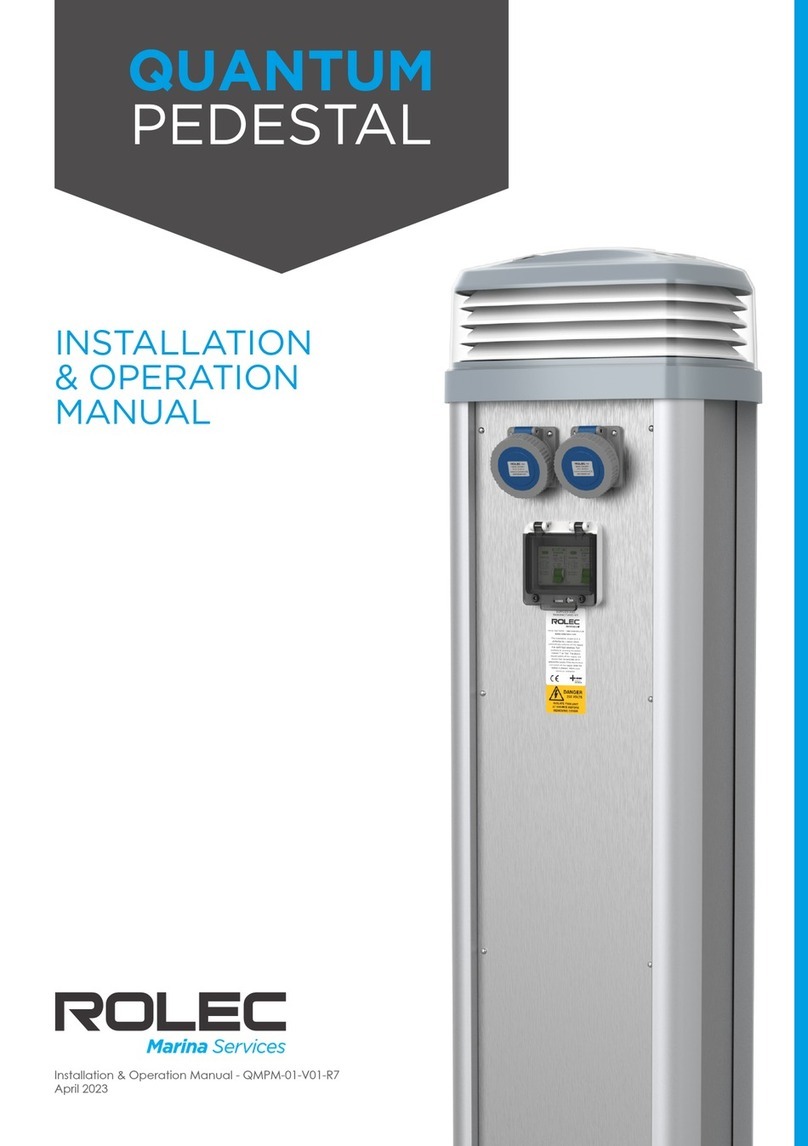
ROLEC
ROLEC QUANTUM PEDESTAL Installation & operation manual

Charge Amps
Charge Amps Ray Type 2 product manual
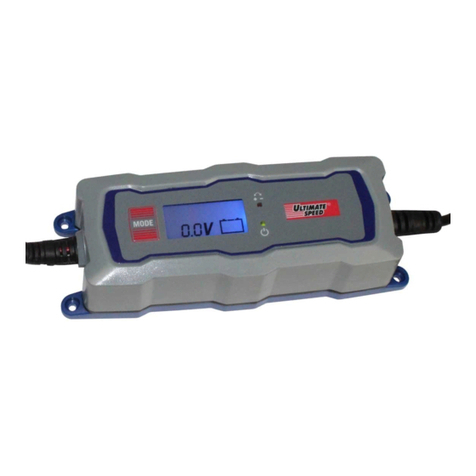
ULTIMATE SPEED
ULTIMATE SPEED ULGD 3.8 A1 Operation and safety notes

Easee
Easee Home quick start guide
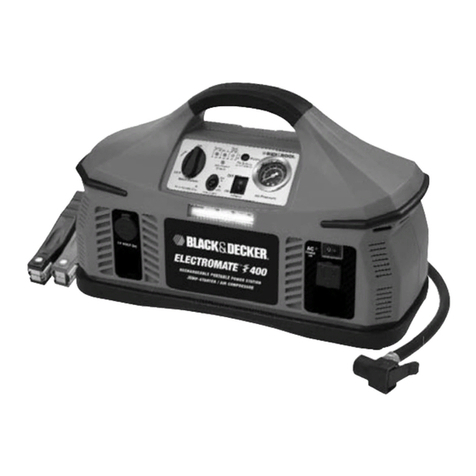
Black & Decker
Black & Decker ElectroMate 90556511 instruction manual

